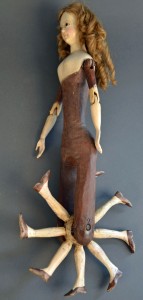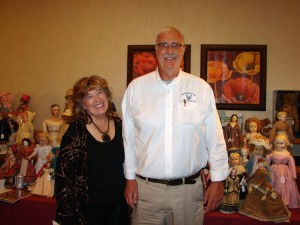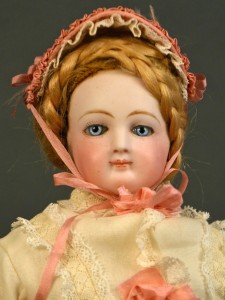Review and Onsite Photos by Rick Russack, Catalog Photos Courtesy Withington, Inc.

At $5,750, the second highest priced item in the sale was this rare walking doll. The body was carved out of one piece of wood, and the elongated torso was cutout to accommodate eight legs, mounted on a wheel that gave the impression that the doll was walking when it was pushed. The head was painted, with black eyes, and it had an elaborate human hair wig. The wooden arms were jointed at the shoulder and elbows. This example was not dressed. A similar companion, with seven legs and antique clothes, brought slightly more, $6,095, making it the top lot of the two-day sale. Neither the auctioneer, nor anyone in the room, had seen other examples.
NASHUA, N.H. — Dick Withington conducted his first doll auction in 1959, and it was a “first in the nation event.” There were no auction houses at that time that devoted an entire sale just to dolls. He would go on to do multiple doll sales a year and they attracted dealers and collectors from a number of states, including California. As his health deteriorated, he had Larry and Marcia Leizure, friends, dealers and neighbors in Hillsborough, assist him with the auction business, and in 2005, at his suggestion, they took over the business, with Dick still doing the selling as long as he was able.
After Dick died in 2008, the Leizures continued in the doll and antique auction business using the Withington name. They conduct about four two-day doll sales, as Dick had done, and they continue to draw the same buyers from the same broad geographical area. Unsurprisingly, the audience, which numbered about 150 people at its most recent sale October 20–21, treats the auction as a social event, having come together so many times for so many years. The Leizures go out of their way to encourage the social aspect of the event. The sales are always on Thursdays and Fridays at the Holiday Inn in Nashua, and the day before, a doll show takes place at the hotel, with dealers setting up in their hotel rooms from 1 pm on. And during the auction, complimentary coffee and snacks are available, as is lunch.
The October sale comprised about 700 lots of dolls and doll-related material, plus 139 lots of vintage dresses, hair jewelry and accessories dating back to the mid-1850s. These 139 lots are the first part of a large collection of vintage clothing that will be dispersed in upcoming sales. Withington doll sales have always included numerous box lots, and this time there were about 200 such lots featuring doll clothes, dollhouse furniture, dolls, boxes of doll parts, supplies for making dresses such as lace and ribbons, as well as books and games. With few exceptions, these box lots sold for under $100.
There were some very unusual dolls in this sale, including two quite rare mid-Nineteenth Century carved and finely painted dolls with possibly unique walking mechanisms. One was dressed and sold for $6,095. One was undressed and brought slightly less, $5,750. Each body appeared to be carved from one piece of wood with an elongated torso, painted faces, black enamel inset eyes, closed mouths, pierced ears and human hair wigs. Each torso was cut out to accommodate a walking mechanism that was wheel shaped with seven or eight painted lower legs, with painted shoes. This wheel would rotate as the doll was pushed along, creating the impression of walking. The dressed example, with seven “legs” sold to a bidder in the room, while the undressed example went to a phone bidder. Nothing is known about the maker or provenance.
Also doing well was a 37-inch French carved wood artist’s manikin with carved facial features and ears, swivel neck and waist and double joints on each finger, which is an unusual feature. A bidder in the room paid $3,335. A musical automaton, a 14-inch Tete Jumeau doll, in original clothes, brought $3,220. When wound, the doll fanned herself, turned her head from side to side and raised a bouquet of flowers to her face.
The walking dolls, as well as some of the other early dolls in the sale, came from the collection of the late Lucie Cripps of Rockport, Mass. From that collection, a 4½-inch tuck-comb wooden doll, with painted features and black molded hair with curls, on a jointed body, reached $575, and another, 8 inches tall, on a jointed wooden body, winner of two blue ribbons, earned $1,265. The term “tuck” refers to the doll’s carved and painted hair, often with curls, and the tall comb that extends above the head. A Queen Ann-type doll, with a gesso finish, blue painted eyes, on a jointed wooden body, with remains of a flax wig, went to a phone bidder for $863.
French fashion dolls, such as Brus, Jumeaus and SFBJs did well, and the top-priced doll in the sale, other than the walking dolls, was a 15-inch French fashion, with an incised 2 on the head. It had blue eyes, closed mouth, pierced ears, original wig, on a jointed wood body. The dress had been made by Virginia Rockwood, and the doll realized $4,600. A 16-inch smiling Bru, incised E, with blue eyes. closed mouth, swivel neck and original clothes with a fur-trimmed train, realized $2,760, and a 19-inch example, incised 110, also with blue eyes and a closed mouth, on a composition body with antique clothes, reached $834.

Larry and Marcia Leizure worked with Dick Withington, and at his suggestion, took over the business in 2005. They continue with the doll auctions in the same place as Withington did. They conduct them the same way and attract the same loyal buyers.
Two 19-inch SFBJ dolls, both incised 238, both in original clothes, ex Dolly Driscoll collection, sold to a bidder in the room. One had won a third place ribbon at a 1991 Doll Collectors of America show, and it earned $1,265. The other had won first place at a 1984 DCA show, and it achieved $2,530. There was applause when the audience realized that the two dolls would remain together.
There were numerous Twentieth Century dolls. A 14-inch Scarlet O’Hara by Madame Alexander, in original clothes and box, achieved $345. An 11½-inch “Cole” by R. John Wright, in original box with certificate, brought just $173, and a 14-inch cloth Kamkins boy doll attained $518. He had painted blue eyes and his original wig. A companion girl doll, went to the same buyer for the same price. A 16-inch Lenci girl, with painted eyes, blond mohair wig, and original clothes, achieved $690. A 13-inch composition Shirley Temple, with sleep brown eyes, and original dress in original box, went out for $288. A Schoenhut doll house, 22 inches long, furnished with Schoenhut furniture, seemed reasonable, selling for $316.
The second day of the sale included more than 100 Nineteenth Century dresses and accessories and some items you might not expect to find at a doll auction. A full plate daguerreotype of Niagara Falls, with more than a dozen tourists by the falls, brought $748 and a miniature on ivory depicting a maiden, sheep and trees ended up at $662. A group of four woven hair rings, including a 15K gold “secret” hair ring, may have been a bargain, finishing at $920. Two circa 1890 children’s outfits, sold together for $1,006. One was a boy’s suit jacket with tails and long pants and the other was a two-piece girl’s dress, with a blue and white pleated skirt and a linen top. A two-piece pale green satin ball gown, circa 1860, having a gathered bodice trimmed in lace, earned $460, and two early 1800s, Empire-style cotton children’s dresses realized $518.

Aside from the two walking dolls, this 15-inch French fashion doll, incised 2, with blue glass eyes, closed mouth, pierced ears and jointed wood body, was the highest priced doll in the sale. It realized $4,600.
Becky and Andy Ourant, Adamstown, Penn., discussed the doll business today with Antiques and The Arts Weekly. Both have been in the doll business for years. In fact, were Becky to say she’s been in the doll business all her life, she’d be on solid ground as her late mother, Roberta Roberts, who was a doll dealer for years, and Becky was always with her mother. They have a doll and toy shop in Adamstown, known as the Village Doll Shop. They have managed major doll auctions for Skinner and Morphy’s, Andy has appeared on the Antiques Roadshow several times and conducted auctions for Noel Barrett and had been associated with Bertoia Auctions.
Both agree that the business has changed and that the economic disruptions of the last decade affected the doll business, as they have other portions of the antiques business. “The interest is strong for fine dolls. Customers today demand fine condition and original outfits and they are willing to pay premium prices when those conditions are met. The top of the market dolls cannot have any scratches on the face or other blemishes. They have to have original wigs, dresses, undergarments, shoes and socks, etc. Sometimes wigs are worth more than a doll. Original antique dresses can sell for up to $1,000, shoes can sell for $500 and socks for $75. These things are important. Today’s collectors want attractive dolls — they are not just buying the mark on the back of the head. They are buying based on the front of the head appearance, and that was not always the case. We also see increased interest in smaller dolls. Size and price used to go together but not today. We are seeing many new collectors. Often, they start with the dolls they played with as children, and as they learn about other dolls, they often become comfortable buying older dolls. Most often, they are learning on their own, they have not grown up in doll-collecting homes. It is a great business — we are in it for life.”
Linda Edward, past president of the United Federation of Doll Clubs, and author of Doll Values, Antique to Modern, one of the two major price guides for the doll world, which she revises every two years, also talked about doll collecting today. “The UFDC is an umbrella organization for doll clubs around the country. Taken together, we have 12,000 members and our primary focus is educating the doll collecting fraternity. The local and regional clubs meet frequently, host events for their members, and newer collectors have access to the knowledge of the older collectors. It is a great way to learn.”
She agreed with the Ourants that often new collectors seek the dolls they had as children. “Many become interested because they want dolls from the 1960s and 1970s. If they’re interested, through the clubs, they are exposed to older dolls. They can handle older dolls and learn from other collectors. Often, they will become confident enough to start buying older dolls.”
After the sale, Marcia Leizure said, “We had a good sale and we had a lot of familiar faces in the audience. Most things brought about what we thought they would and the dresses on the second day were strong, especially accessories like the hats, bustles and stuff. The hair jewelry did well, and we thought the daguerreotype of Niagara Falls also did. We are looking forward to next year’s sales and we have some interesting collections lined up. Some of the older collections are coming to market now and that gives today’s collectors the opportunity to see and buy some really scarce dolls.”
All prices reported include the buyer’s premium.
For additional information, www.withingtonauction.com or 603-478-3232.



















